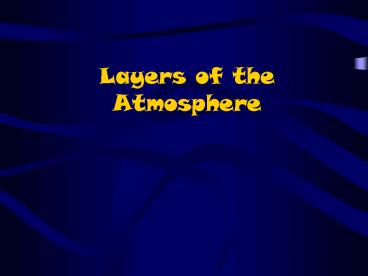Layers of the Atmosphere - PowerPoint PPT Presentation
1 / 16
Title: Layers of the Atmosphere
1
Layers of the Atmosphere
2
Atmospheric Layers
- The atmosphere can be divided into five layers
with transitional regions between most. - Each layer possesses individual characteristics,
the most important differences are in temperature
and air pressure.
3
Atmospheric Layers
- The five distinct layers are
- Troposhere
- Stratosphere
- Mesophere
- Ionosphere (thermosphere)
- Magnetosphere
4
Troposphere
- The layer directly above the Earths surface.
- This layer is where all of the Earths weather
occurs. - Air currents and the friction caused by the
Earths rotation make currents in the troposphere
the roughest of all layers. - Located from the Earths surface up to
approximately 10 km.
5
Tropopause
- The transitional layer that separates the
troposphere and the stratosphere. - It ranges from 16 km at the equator to only about
9 km at the poles. - The temperature stops falling and stabilizes at
approximately -55 C.
6
Stratosphere
- This layer contains
- The jet stream Affects the movement of storms
in the troposphere. - The ozone layer Filters out harmful solar rays.
7
Stratosphere
- Vertical air movement is minimal but there are
horizontal currents (jet stream). - Studying jet streams helps to determine daily
temperatures and precipitation.
8
Stratopause
- The transition zone between the stratosphere and
the Mesosphere. - Temperature stops increasing and thins out with
altitude. - This layer is the beginning of the outer
atmosphere.
9
Mesosphere
- The temperature drops steadily until it reaches
about -100 C. - In the Mesopause (transition zone) the
temperature stabilizes and rises once again.
10
Ionosphere
- The widest layer ranging from 80 to 480 km.
- The is very little air at this level. Air
temperature increases. - As electrons and ions are created in the
ionosphere radiant energy is converted into
thermal energy.
11
Magnetosphere
- This layer sometimes traps solar wind.
- Solar wind results when magnetic storms on the
sun send streams of radioactive particles towards
Earth. - The rotation of the Earth makes the planet behave
like a magnet. The charged particles from the
sun align themselves with the North and South
poles, forming streaks of light in the sky.
12
Magnetopause
- This layer forms a sharp divide between the
atmosphere and space. - Unlike the other layers the magnetopause does not
form a symmetrical layer around the Earth, it is
shaped like a tear drop.
13
Whats the Diff?
- There are 3 main differences between Plants and
Animal cells - Cell Wall
- Chloroplasts
- Vacuole
14
Cell Wall
- The Cell wall is a fibrous wall that provides
structure and support for the plant cell. - The cell wall is made up of a material called
cellulose.
15
Chloroplasts
- The Chloroplasts are the organelles that allow
plant cells to make their own food through the
process of photosynthesis.
16
Vacuoles
- Both plant and animal cells have vacuoles.
- Vacuoles are much larger in plant cells because
plant cells need to be able to store more water
than animal cells.































